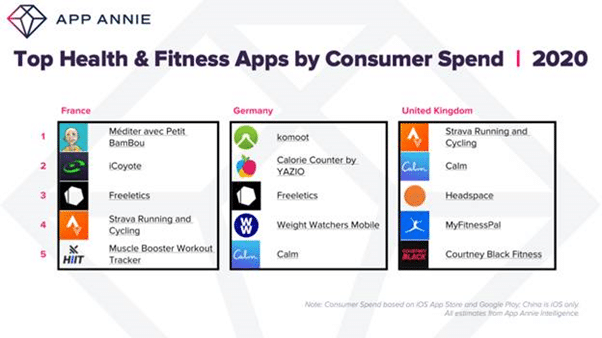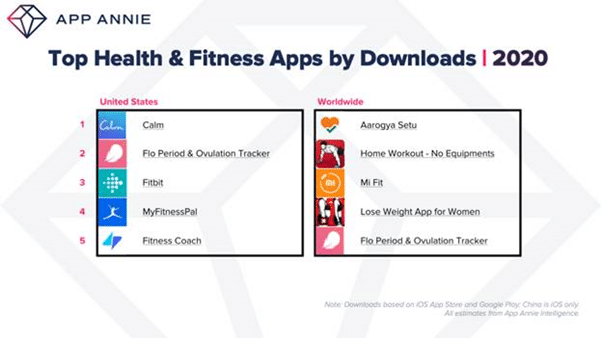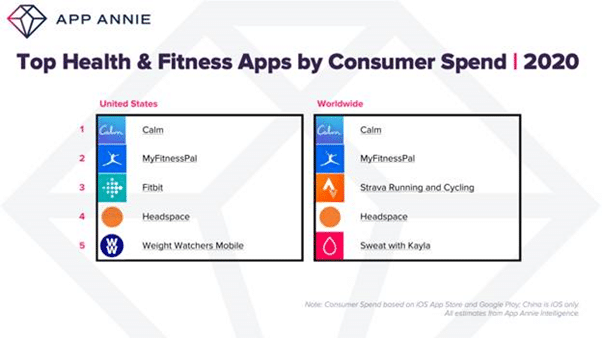
If you can guarantee one thing about the Health and Fitness app market it is this: downloads will explode in January, then taper during the rest of the year. Why? It’s when holiday excess and new year’s resolutions inspire millions of people to get fit.
But, last year was different. App Annie, the leading mobile data and analytics company reveals. March was the start of COVID-19 lockdown in most regions. With gyms closed, people looked for different ways to get active. Health and Fitness app downloads hit 59 million during the week of March 22, 2020 — up 40% on the weekly average for January and February 2020.
Key data points
Health and fitness sustained its impressive performance across the full 12 months.
Health and Fitness – consumer spend up 30%
- 2020: $2.0 billion
- 2019: $1.5 billion
Health and Fitness – app downloads up 30%
- 2020: 2.6 billion
- 2019: 2.0 billion
Health and Fitness – time spent up 25%
- 2020: 5.4 billion hours
- 2019: 4.3 billion hours
Consumer spend in the UK was up 70% to $172 million.

App Developers Launched More than 71,000 New Health and Fitness Products in 2020
• App Annie estimates that in 2020, more than 71,000 health and fitness apps were released globally. That’s up 13% on 2019. On iOS, the number was 24,000. On Google Play it was 47,000.
• There was a clear diversity in the top apps. Contributing most are the workout/fitness apps. The standout performers in terms of worldwide downloads were Home Workout – No Equipment (# 2), Mi Fit (#3) and Lose Weight App for Women (#4).

Sleeper Hit: Calm Helps People Cope with Anxiety – and Leads the Health and Fitness Category in Consumer Spend
• However, health and fitness is not just about physical exercise. The isolation and anxiety caused by lockdowns drove up demand for apps that improve mental wellbeing. The top global product in terms of consumer spend for 2020 was sleep/meditation app Calm.
o In 2020, Calm even moved into the corporate space. It sealed a partnership with American Express to give cardholders free access to Calm as a membership extra.
• In fourth place was another wellbeing and mindfulness product, Headspace. Consumer spend is not the only metric to measure success of mindfulness and meditation apps — time spent can also be an important indicator for those that monetize outside the app stores.

COVID-19 Track and Trace Apps
• In 2020, there was one final group of products that appeared for the first time ever in the Health and Fitness category: contact tracing apps. Most countries — or in the case of the US, states and cities — launched their own version of products designed to track positive COVID-19 cases. Unsurprisingly, these products had a significant impact in the category. Indeed, the world’s most downloaded Health and Fitness app globally was India’s Aarogya Setu.
Lexi Sydow, Senior Market Insights Manager at App Annie says, “2020 bucked seasonal trends due to a world turned upside down from a global pandemic. In 2020 it was April, not January, that saw the biggest spike in downloads of Health and Fitness apps globally at 276 million, up 80% year over year. We tend to see consumer spend spikes follow downloads shortly after, which was true in the months after April, but spend hit a global high of $185 million in August 2020, up 45% year over year. As consumers hunkered down at home, ‘at home’ fitness surged and we saw an uptick re-emerge during the second major waves of lockdowns in the Americas and Europe. In the new normal of 2021, home will remain the epicenter of our social, working and wellness lives — with mobile driving an acceleration of 43% in “at-home” activities”
